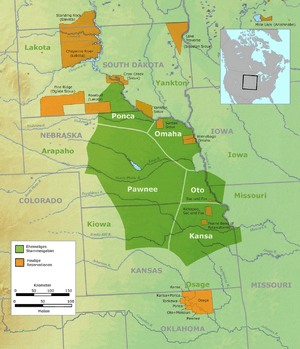Effects of white settler contact on the Pawnee tribe facts for kids
This article explores how the Pawnee tribe was affected by contact with white settlers. The Pawnee are a group of Native American people. They were known for being peaceful with settlers, which earned them the name "friendly tribe." The Pawnee tribe was made up of four main groups: the Kitkehahki, Chaui, Pitahauerat, and Skidi. These groups lived separately, making the tribe quite independent.
The Pawnee lived in what is now Nebraska for hundreds of years. However, their lives changed a lot after European settlers arrived. They lost their land, many people died from new diseases, and they started to adopt European ways of life.
Contents
Losing Their Land
The Pawnee lived along a river in Nebraska for a very long time. This was their home before Europeans arrived in the 1540s and well into the 1800s.
Over time, the Pawnee gave up most of their land in Nebraska. They did this through agreements with the United States government in the 1800s. In 1833, the four Pawnee groups gave up their lands south of the Platte River.
Later, in 1857, the tribe was moved to a smaller area. This was a reservation on the Loup Fork of the Platte River. By 1874, the Pawnee had lost all their land in Nebraska. They were then moved far away to Oklahoma.
Losing Many People
Even though the Pawnee usually got along with settlers, there were many sad results. One of the biggest problems was a huge loss of life for the tribe.
The Pawnee suffered greatly from diseases brought by Europeans. In 1849, over a thousand Pawnee people died from a cholera outbreak. More people died from smallpox in 1852.
The Pawnee population was between 7,000 and 10,000 people in the early 1800s. By 1875, this number had dropped to about 2,500.
Adopting New Ways
Europeans also strongly encouraged the Pawnee to adopt their customs. This effort began in the mid-1700s. The Pawnee tried to resist, but they were forced to change after 1854. This was when they were moved to the small reservation.
New Goods and Tools
Around 1750, horses and guns became part of Pawnee culture because of European contact. This shows when settlers started to have a bigger impact on the Pawnee way of life. Guns began to replace bows and arrows as the main weapon for the Pawnee after 1800.
Horses and guns both made the Pawnee stronger for a while. The Pawnee had been struggling with attacks from other Plains tribes. Their independent nature made it hard to defend themselves.
At first, horses were used to carry supplies, like stronger versions of dogs. But by the early 1800s, Pawnee herds had between 6,000 and 8,000 horses. Having horses made the Pawnee much better at hunting buffalo. However, it also brought the European idea of owning lots of wealth.
The British gave guns to the Pawnee. The British wanted to arm anyone who might fight the Spanish, as European countries battled for control of North America. The Pawnee gained a strong advantage over other Plains tribes who did not have guns from European traders. This made them the most powerful tribe in the area into the 1800s. But they lost this advantage after the 1833 agreement.
Settlers brought many different trade goods into Pawnee culture. For 200 years after their first contact in the mid-1500s, European goods were not a big part of Pawnee life. But this changed quickly after 1750. Europeans introduced items into all parts of Pawnee culture. This included weapons like iron knives and lead bullets. They also brought tools like awls and axes. Even accessories like buttons, bracelets, and brass bells became common.
What Archeology Shows
Studies done between 1930 and 1941 show how European items became more common among the Pawnee. These studies looked at Pawnee sites from 1571 to 1867. They found very few European items from before 1800. But after 1800, there was a huge increase in European goods. By 1833, European items had almost completely replaced traditional Pawnee ones.
Changes in Religion
Before European contact, the Pawnee had a unique and detailed religion. It was based on natural landmarks and special ceremonies. Priests led rituals that honored their beliefs about where they came from. Healers believed their powers came from spiritual forces. The Pawnee thought animals were like "earthly messengers for sky gods." Animals were very important in their religion. However, these traditions faded or became less important as the tribe adopted more European ways.
A major change in Pawnee religion was the end of the Morning Star ceremony. This was a traditional ceremony for one village in the Skidi Pawnee group. It was part of their beliefs about renewing the earth. The ceremony happened in the 1810s. American officials warned that white settlers would not approve. News of the ceremony reached the eastern U.S. around 1820. Some leaders in the village began to oppose the ritual because of this disapproval. The last known ceremony took place in 1838.



